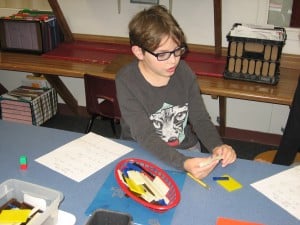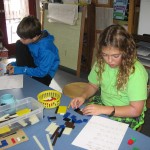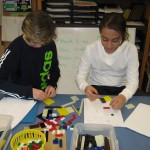
After working with the basic tile problems, students move into more complex, multi-step problems:
1/4 + 1/3 + 1/2 = ? /24ths or 1/2 + 1/3 + 1/6 shared by 2 people. Each person gets ?/24ths.
When students are ready to step away from the Bixby tiles and they are ready for a less concrete approach, they may use graph paper rectangles to represent the whole. A typical problem could be: Draw a rectangle with 16 little squares inside (so the first step is to figure out the dimensions of this rectangle; it could be a 4×4, a 2×8 or a 1×16). The next step is to find and draw 1/16th, 1/2, 1/4 and 1/8th of it.
The final step of working with fractions is to work with the numbers only (no manipulatives and no graph paper). A problem might be: A full garbage truck weighed 9 and 3/4 tons. After dumping the garbage, the truck weighed 3 and 5/9 tons. What was the weight of the garbage?
Students also learn to add/subtract fractions with like and then unlike denominators, when a student shows his/her readiness. Children need lots of time and varied experiences to understand and work with fractions. Fun and related activities are a welcome addition to our fraction unit: coming up, we will be using sectioned chocolate bars to find equivalent fractions, as well as adding and subtracting fractions.





